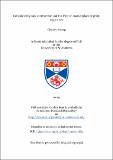Files in this item
Catholic religious controversy and the French marketplace of print, 1535-1572
Item metadata
| dc.contributor.advisor | Pettegree, Andrew | |
| dc.contributor.author | Kemp, Graeme | |
| dc.coverage.spatial | Vol. I: xi, 298; Vol. II: xxxi, 152 | en_US |
| dc.date.accessioned | 2013-06-26T15:34:33Z | |
| dc.date.available | 2013-06-26T15:34:33Z | |
| dc.date.issued | 2013 | |
| dc.identifier.uri | https://hdl.handle.net/10023/3821 | |
| dc.description.abstract | This thesis is an examination of Catholic religious controversial publication in France between 1535 and 1572. Although this encompassed a period of great political and religious turmoil, the Catholic publications of these tears are comparatively under-researched. The publication of controversial writings has more commonly been associated with the period after the Edict of Nantes in 1598. This study seeks to address this gap in research by a quantitative assessment of the volume of Catholic controversial printing during the mid-sixteenth century and its broader place within the publishing industry. Religious controversy formed an important component of the religious book trade in the sixteenth century at a time when the print industry itself was in a process of reorientation. Many of the forms of religious controversy familiar in the seventeenth century would find their roots in the discourse of the sixteenth century. The first section of this study lays the groundwork for the analysis of the period 1535 to 1572. Chapter one looks at the beginnings of religious controversy in France and provides a brief overview of the market for religious print in the early sixteenth century. Chapter two builds on this analysis to chart the emergence and extent of Catholic responses to Lutherianism. Chapter three concentrates on the emergence of Reformed controversial writings and quantifies their output. The second section of this thesis presents a quantitative analysis of Catholic controversial works, Chapters four and five outline the contours of the book trade in France at the time. Chapter six assesses the volume of Catholic controversial literature produced and its relationship to the other genres. Chapter seven examines the printers and publishers who played a pivotal role in its production. Finally chapter eight examines the development of the genre with a typology of controversial literature investigating different approaches to such writing. A comparison with seventeenth century, pursued in the conclusion, draws out the lessons of the early development of a genre that was both critical to the defence of French Catholicism in the sixteenth century and the erosion of the privileged Huguenot minority in the decades after the Edict at Nantes. An appendix of all Catholic controversial editions printed between 1535 and 1572 is included. This formed the basis of the study and provides the first comprehensive catalogue of its kind. It features over 1,500 entries with numerous full bibliographic descriptions. | en_US |
| dc.language.iso | en | en_US |
| dc.publisher | University of St Andrews | |
| dc.subject.lcc | BX1775.F7K4 | |
| dc.subject.lcsh | Catholic Church--France--Controversial literature--History and criticism | en_US |
| dc.subject.lcsh | Reformed Church--France--Controversial literature--History and criticism | en_US |
| dc.subject.lcsh | Printing--France--History--16th century | en_US |
| dc.subject.lcsh | Printers--France--History--16th century | en_US |
| dc.title | Catholic religious controversy and the French marketplace of print, 1535-1572 | en_US |
| dc.type | Thesis | en_US |
| dc.type.qualificationlevel | Doctoral | en_US |
| dc.type.qualificationname | PhD Doctor of Philosophy | en_US |
| dc.publisher.institution | The University of St Andrews | en_US |
| dc.rights.embargoreason | Embargo period has ended, thesis made available in accordance with University regulations | en_US |
| dc.identifier.doi | https://doi.org/10.17630/10023-3821 |
This item appears in the following Collection(s)
Items in the St Andrews Research Repository are protected by copyright, with all rights reserved, unless otherwise indicated.

